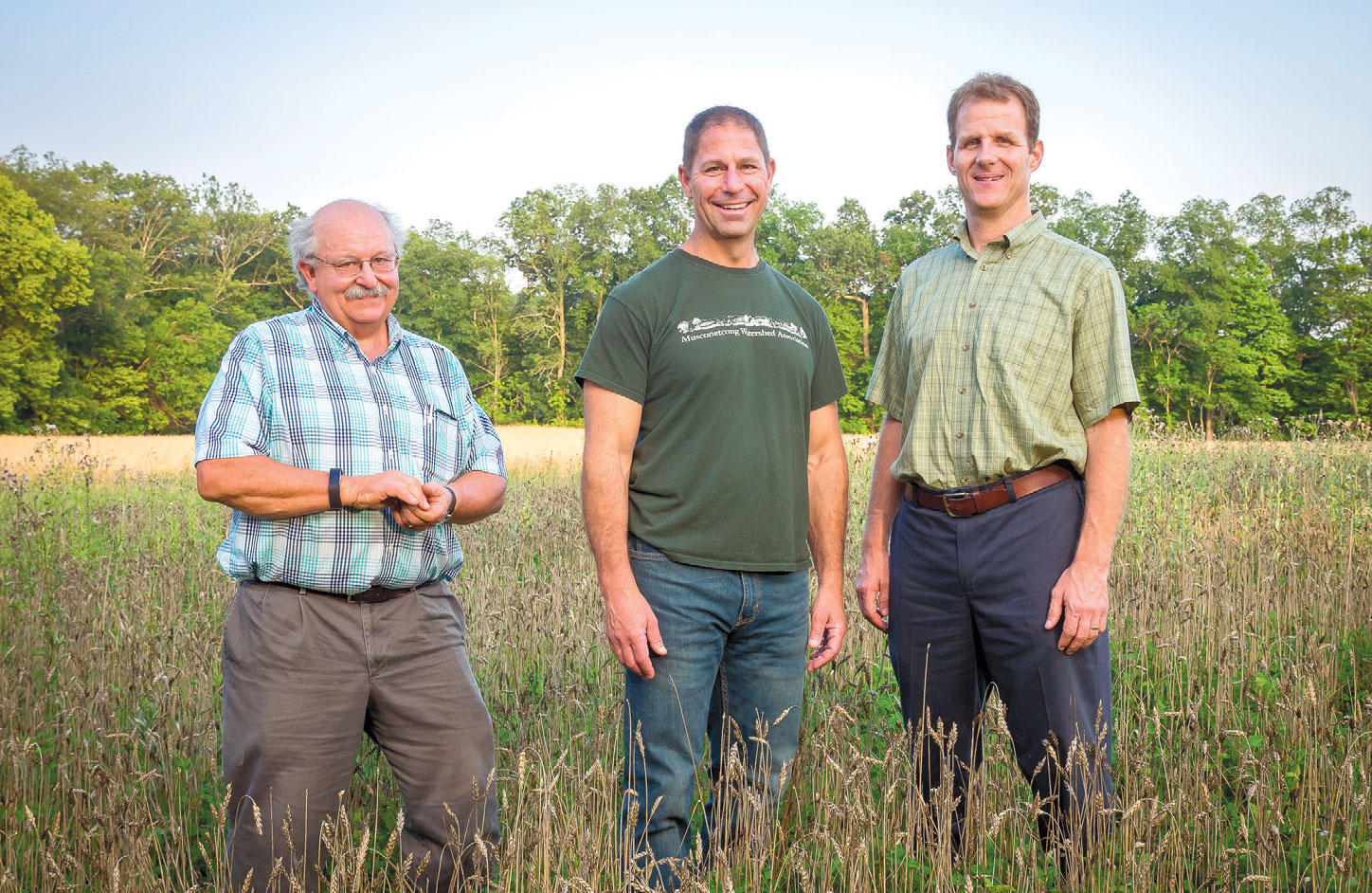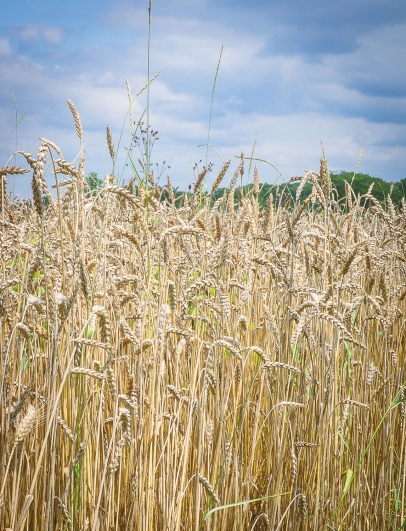Amber Waves
The Struggle to Rebuild a Hub for Local Grains
On January 21, 2017, as millions of women marched in Washington DC and cities around the world, a small group of farmers, bakers and local food advocates gathered at Long Valley’s Middle Valley Community Center to plot their own disruption of the status quo. Billed as a gathering to explore “re-establishing our agricultural heritage by creating a local, organic grain hub,” the meeting highlighted the challenges and successes of River Valley Community Grains, a fledgling company working to re-localize the growing and processing of wheat and other grains. Eighteen months later, despite the enthusiastic reception their flour has received from artisanal bakers, River Valley Community Grains remains more a dream than a reality—a testament to the significant challenges of rebuilding the infrastructure and market for local grains.
Over the past two and a half years, Mike Hozer, Len Bussanich and Larry Mahmarian have devoted considerable brain power, muscle and time into laying the foundation for River Valley Community Grains. Employed, respectively, in the financial information, recreational equipment and global workforce mobility industries, the trio seems an unlikely group to take on the challenge of rebuilding the local grain economy. But their enthusiasm for the work is clear. And their affection and respect for each other is evident in the good-natured way they work together to overcome the obstacles they encounter as they pursue their dream of producing high-quality organic grain and flour in a way that restores the soils, water and health of their community.
Hozer, Bussanich and Mahmarian cite various personal motivations for working in local foods—ranging from concern for our environmental legacy to a love of the outdoors to the desire to participate in positive change. The choice to narrow their focus to grain was inspired by a vision put forth by Sister Miriam MacGillis of Genesis Farm in Blairstown. Hozer first heard MacGillis talk about grains at a small meeting they both attended in 2013 to explore options for ecologically beneficial local food production along the Musconetcong River, which flows from Lake Hopatcong to the Delaware and defines the southern boundary of Warren County with Morris and Hunterdon counties. At that meeting, MacGillis showed a small aerial map of the area around Genesis Farm, which included a section of the river. She explained that a colleague whose wife worked at Whole Foods Market said that the company could not find enough local, organic grain and flour to supply their bakeries. MacGillis suggested starting grain production and processing in the region to help fill that demand.
At a much larger gathering in 2016 at Hawk Pointe Golf Club in Washington (NJ), MacGillis introduced a more fully formed idea—restoring the Musconetcong River Valley, a project to both honor the sacredness of the river valley and restore the health of its soil, water and farms. She aligned that meeting’s dual goals of strengthening the local food economy and protecting the Musconetcong watershed by showing an extensive aerial photograph of the Musconetcong River Watershed. That photo made clear the significant impact that agriculture has on the river.
“It’s really interesting looking at the adjacent, contiguous fields along the river valley,” Hozer says. “The realization that almost all of it is in chemical farming for [animal] feed. And, it gets shipped out. Hardly anybody is growing food for the area. It just seemed shocking when you see all of these fields and you think about what’s happening to the soil, the water. And we are importing all this food from across the country and around the world. We could be growing healthy food right here.”
MacGillis explained that farmers and millers in the northeast could not keep up with the demand from professional and home bakers for local, organic flour. She again proposed that a local grain hub—a centrally located facility that aggregates, processes and distributes locally grown grains—could help replace imported flour with a locally grown product and provide farmers along the river with an economic incentive to transition to organic practices, which would help restore health to the soils and waters in the Musconetcong watershed. Hozer, Bussanich and Mahmarian decided that this was an idea that they wanted to pursue, and, several months later, River Valley Community Grains was formed.
“The short-term thinking that we have is like a disease in our culture. We’re focused on the quarterly earnings statements—what’s happening right now— as opposed to the way the Native Americans used to think: seven generations ahead. What are we leaving our children? They are inheriting this soil from us, this water, this food supply, these farms.”
—Mike Hozer, River Valley Community Grains

Farmer Kent Kimball (left), of Kimball’s Farm in Belvidere, with Mike Hozer and Leonard Bussanich.
Rebuilding the NJ Grain Industry: Is It Feasible?
Raising grain in New Jersey is not a new idea. In the 18th century, New Jersey was one of the mid-Atlantic “bread colonies” and wheat was an important export crop for farmers. In The Early Grist and Flouring Mills of New Jersey, authors Harry B. Weiss and Robert J. Sim write that “During Colonial times the wheat belt in New Jersey stretched from New York City to Philadelphia. By 1750 the New Jersey colony had progressed rapidly in milling, and much of the flour marketed in New York City came from the region around New Brunswick. In the first half of the 18th century the New Jersey flouring mills were considered as the best in the country.”
In those mills, the remains of which can still be seen along the banks of our state’s rivers and major streams, grain was ground between millstones, which crushed the entire kernel (endosperm, bran and germ) into flour. Although some of the bran and germ could be sifted out, the volatile oils in the remaining bran and germ turn rancid with prolonged exposure to air, shortening the shelf life of stone-ground flour. The arrival of the roller mill in the late 1800s enabled the miller to remove the germ and bran—and, with them, many of the nutrients and much of the flavor. Flour changed from a locally produced, perishable food into a shelf-stable, commodity product, making it impossible for our farmers and millers to compete against large Midwestern growers and mills. By 1955, only one flour mill remained in New Jersey.
The obstacles to growing grain profitably again in New Jersey are considerable—beginning with the economics of farming. At the January meeting, farmers challenged some of the assumptions and predictions that were being offered by Hozer, Bussanich and Mahmarian, and their invited guest speakers.
Noting that he lost money years ago growing grain, organic vegetable grower Kurt Alstede of Alstede Farms in Chester questioned the economic viability of grains given the high cost of farmland in New Jersey. The expense of harvesting equipment was also discussed. A proposal that farmers share equipment was quickly shut down; grain has a narrow window for ideal harvest, meaning that growers at the end of the harvesting schedule would risk crop loss due to rain and other factors. And conventional grain grower Scott Clucas of Clucas Farms in Oldwick brought up the crucial issue of markets for niche products, such as local flour, and how the promised financial returns don’t always materialize for farmers, who take on considerable risk when growing a new product for an emerging market.
Speaker Elizabeth Dyck, founder and coordinator of the Organic Growers’ Research and Information-Sharing Network and a key consultant to River Valley Community Grains, noted that high-quality organic wheat commands $15 per bushel and higher, whereas $4 per bushel is considered a good price for conventional wheat. And she gave examples of several farmers who have made the economics of local grain work. A farmer in Ontario, she said, makes a living selling his hand-processed grain direct to consumers. And Thor Oechsner, an organic grain farmer in New York State, built a mill and bakery to ensure markets for his grain. Despite those successes, Dyck cautioned that over-saturating the market will undercut the price premium that local grains and flour now receive. She advises farmers to begin by planting only a few acres of grain as the market builds.
Steve Gambino, owner of Villa Milagro Vineyards in Finesville, is one farm owner at that meeting who had already followed that advice. In spring 2016, Gambino, with technical guidance from Dyck, planted five acres of wheat, managed under organic practices. The harvest was wildly successful, yielding 14,000 pounds of excellent quality bread wheat (see sidebar). It also created a logistical challenge that catapulted the founders of River Valley Community Grains into simultaneous roles as processing facilitators and market builders.
To compete against low-price, high-volume commodity grain, value must be added to local grain at every step of the journey from farm to end user. The goal: Create quality attributes that command a price premium from wholesale and retail customers. The public has already shown a willingness to pay a premium for “locally grown” and “organic.” A price premium can also be gained by the planting of flavorful heritage and modern wheat varieties. And milling adds value by turning grain into flour.
Because the infrastructure for grains has largely disappeared in our state, milling the initial batch of Gambino’s wheat proved to be a time-, labor- and resource-intensive exercise for Dyck and the River Valley Community Grains founders. The long journey from grain to flour began when Hozer picked up 500 pounds of wheat at Villa Milagro and drove to the Delaware Water Gap where he met Bussanich and handed off half the load. “People were driving by and seeing us hand over these white bags,” Bussanich recalls with a laugh, “and looking at us like ‘what are these guys doing over there?’” They drove to Dyck’s farm in the Western Catskills where the wheat was cleaned. Dyck took the cleaned grain to Beiler’s Heritage Acres in Lancaster, PA, where it was milled into flour, which was transported back to New Jersey.
From the resulting 350 pounds of flour, samples were given to several bakers, including Linda Curcio of Hampton Junction in Hampton and Bill Harper of Harper’s Bagels and Bakery in Hackettstown. Hozer, Bussanich and Mahmarian wanted feedback from these bakers on the quality and workability of local flour—and to begin to get a sense of the potential market demand. “A lot of the bakers that we have talked to so far are very receptive to this,” Mahmarian says. “After Linda tried the sample, she wanted more. Bill Harper, same thing, looking for more. Working with Steve really helped us validate a lot of the end-market customer assumptions that they were hoping to experience.”
At the January meeting, sample bags of the flour were given out to attendees. And baker Kate Munning used it to make breads and cookies that were served with lunch (see sidebar). “We hope that this bread represents the first step of many in a wider vision to create a viable and durable model of grain processing for human consumption,” Bussanich told meeting attendees, “thus re-creating the tradition of what was once a significant part of New Jersey’s rich agricultural heritage.”
Educating, and Liberating, Bakers
That initial batch of flour was also used in a day-long local-flour baking class organized by River Valley Community Grains and led by Nina White of Bobolink Dairy & Bakehouse in Milford. White, who has extensive experience working with flour from small-scale mills, guided her twelve students through experiments in which they made a variety of loaves using flour milled at three different rates of extraction. (Extraction is the percentage of the whole grain that remains after sifting; 100% extraction, for example, means that none of the bran or germ has been removed.)
White emphasizes that the success of re-localizing grain and flour depends on the willingness of bakers to develop a sensory approach to baking. This allows bakers to respond to the differences in gluten content, water absorption and flavor among locally milled flours, which lack the consistency that large mills achieve by blending vast quantities of flour. By shifting away from strict adherence to recipes, bakers can better accommodate variability in the way locally milled flour performs—a reflection of differences that farming conditions, timely harvest and other factors make to the way flour behaves during the making of breads and pastries. For White, adapting to that variability liberates bakers—and farmers—from the expectation that flour must behave consistently, regardless of the place, farming practices and conditions in which it is grown. “I think it is very important for us to know how to set up an exploration of a new raw material,” White says. “Because, if we are guided by the recipe and the method, then our agriculture has to be geared towards its end use exclusively—and we get involved in some crazy practices to produce products that are not necessarily a natural progression of the environment.”
River Valley Community Grains produced an additional 750 pounds of flour from Gambino’s wheat, which they then sold to Curcio, Harper and Pastoral Pig in Flanders as well as a few home bakers and the baker at Genesis Farm. White also purchased a significant amount of flour ground from Gambino’s initial crop of wheat to make breads for the Ryland Inn and her own shop and farm stand.
Re-educating bakers and finding farmers who are willing to transition some land to organic grains—or add grains into their organic vegetable rotation—is all part of what Gambino described at the Long Valley meeting as “a bit of a chicken and egg situation” in which Hozer, Bussanich and Mahmarian are hoping to simultaneously ratchet up supply and demand over time. The goal is to ensure that farmers have a reliable market and bakers a reliable supply. The crucial missing piece of that plan is establishing a centrally located mill.
Crop Losses and Equipment Fees
Hozer, Bussanich and Mahmarian have explored various funding models for the purchase of milling equipment, with the hope of finding community-minded investors who value River Valley Community Grain’s mission. Fortunately, there is compact milling equipment that will allow them to start small and to grow as supply and demand increase. “When you look at the components of being able to take a harvested grain to flour, it’s not enormous,” Mahmarian says. “You don’t need a massive facility. We just need the right components, logistically connected in the right way. It can be done relatively easily.”
The trio estimates that equipment for cleaning and milling the grain will run between $11,000 and $19,000. And they plan to run the mill in rented space in the Red Barn Kitchen Incubator in Long Valley for at least their first year. Even with these relatively minimal requirements, however, funding remains elusive. And, a near total crop loss in 2017 was a stark reminder of the unpredictable nature of agriculture. Last year’s rye crop had a toxin level that measured too high to meet food grade, and five acres of wheat were lost when the promised loan of a neighbor’s combine failed to materialize in time. This year, they anxiously await the upcoming harvest of fifteen combined acres of grain planted by farmers who support the goals of River Valley Community Grains.
Still, the founders remain optimistic. Enumerating their successes, which include the transitioning of some acreage into organic management, the education of bakers and highlighting existing demand from retailers and chefs, Hozer expresses cautious confidence in the future of River Valley Community Grains. “I feel fairly certain that we can make the economics work out if we stay focused on our purpose and mission,” he says, “and if we have the right folks involved that believe in the mission but also have the business savvy and the financial background to set that up in the right way.”
As they continue to balance full-time careers with their volunteer efforts on behalf of River Valley Community Grains, the three men remain doggedly committed to creating the community grain hub that is vital to MacGillis’ larger vision of the ecological and spiritual restoration of the Musconetcong River valley. Despite the slow pace of progress, they take the long view when assessing the value and necessity of their project.
“The short-term thinking that we have is like a disease in our culture,” Hozer says. “We’re focused on the quarterly earnings statements—what’s happening right now—as opposed to the way the Native Americans used to think: seven generations ahead. What are we leaving our children? They are inheriting this soil from us, this water, this food supply, these farms. It seems to me that we can plant some seeds, so to speak, to rebuild the soil, clean the water and create a healthy local food supply.”
[ A BAKER’S PERSPECTIVE ]
Commercial flour is ground with a roller and stripped of much of the grain’s nutrition—namely the bran and the germ. It’s often treated with bleach and potassium bromate (which has been banned in many countries), and then “enriched” with artificial vitamins since the natural ones have been lost in the process. This results in a homogenous product with a long shelf life, and it makes for consistently fluffy baked goods—but at a cost.
River Valley Community Grains, on the other hand, uses organic methods to grow heritage grains that actually improve farmland rather than deplete it. These grains are stone ground, which preserves the fiber and vitamins for a healthier, more flavorful flour. It’s best used fresh, within 3 to 6 months, and the protein content can vary from batch to batch. This can be an initial challenge for both home and professional bakers, since the same recipe can yield different results. But as with anything, the more you work with whole grain flour, the less intimidating it is. River Valley Community Grains tests the protein content of all its grains, and we’re experimenting with different extractions and grain varieties to figure out what’s easiest for consumers.
What I love most about River Valley’s flour is the taste. The high-quality soil these grains are grown in and the freshness of the flour contribute a rich, unmistakable nuttiness and depth of flavor. If you’re just starting out and want to guarantee success, try using this flour in familiar recipes for cookies, muffins or pancakes. You’ll get all the benefits without much risk. I make these 100% whole wheat butter cookies with cacao nibs that are dead simple and deliciously decadent. If you’re a bread baker, you can replace small amounts of commercial flour with stoneground whole wheat at first, then increase and tinker with methods to suit your needs. I found I could use 50% whole wheat in my favorite sourdough bread and still get a lofty rise and beautiful, open crumb, thanks to a long, cold overnight proof. This flour is more versatile than many people might think. —Kate Munning

WHEAT FLOURS AND HOW THEY DIFFER
Because flour is key to the structure of baked goods, using the correct type of flour is important. Wheat is classified according to its hardness, color of the bran and growing season. Hard wheats have a higher amount of gluten (storage proteins that give elasticity to dough), making them better for bread making. Soft wheats are best for pastry. The six classes of wheat are:
HARD RED WINTER
Versatile, used in pan bread, Asian-style noodles, hard rolls, flat breads, tortillas, general purpose flour and cereal.
HARD RED SPRING
Aristocrat of wheat, used in hearth breads, rolls, croissants, bagels and pizza crust.
SOFT RED WINTER
Versatile weak-gluten, used in cookies, crackers, pretzels, pastries and flat breads.
SOFT WHITE
Low moisture with high extraction rates, used in cakes, pastries, Asian-style noodles, Middle Eastern flat breads.
HARD WHITE
Used in Asian-style noodles, whole wheat white flour, tortillas, pan breads and flat breads.
DURUM
The hardest of all wheats, used in pasta, couscous and some Mediterranean breads.
source for classifications: USWHEAT.ORG
Specific varieties, such as Red Fife, Warthog and Glenn, exist within these classifications.
"I'm not really tempted to bake bread with a [soft] wheat that is 8% protein," says Nina White of Bobolink Dairy & Bakehouse. "That's asking for trouble. I'll be very happy to make biscuits or pie crust with that wheat. That's a very short fiber gluten, which will make a really nice, crisp cookie." If using high protein bread flour to bake cookies, White recommends removing the cookies from the oven before browning to ensure they remain crisp, rather than tough.
Another key to good baking, White says, is to always use a scale, which is a much more accurate way to measure flour than measuring by volume.
GRAINS AND ECOLOGICAL REPAIR
 When Elizabeth Dyck, founder and coordinator of the Organic Growers’ Research and Information-Sharing Network, returned to the East Coast after working in Minnesota, she was struck by how rare it was to find vegetable farmers planting small grains, such as wheat, barley, oats, and rye, as cover crops within their crop rotations.With the growing consumer demand for these crops as part of the local food movement, she thinks it is time for that to change. While Dyck acknowledges the complicating factors of harvesting, processing and selling small quantities of grain, she has made it her mission to enlighten growers to both the ecosystem benefits that these grains provide and their profit potential.
When Elizabeth Dyck, founder and coordinator of the Organic Growers’ Research and Information-Sharing Network, returned to the East Coast after working in Minnesota, she was struck by how rare it was to find vegetable farmers planting small grains, such as wheat, barley, oats, and rye, as cover crops within their crop rotations.With the growing consumer demand for these crops as part of the local food movement, she thinks it is time for that to change. While Dyck acknowledges the complicating factors of harvesting, processing and selling small quantities of grain, she has made it her mission to enlighten growers to both the ecosystem benefits that these grains provide and their profit potential.
Using rye as an example, she explained to farmers at the January 2017 meeting in Long Valley that rye's fibrous root system spreads out to scavenge nutrients.This helps to break up the soil. And, when those roots die and decay, they leave behind organic matter which aids in the storage of nutrients and water and in fighting soil compaction. Grains also leave behind straw, which builds organic matter when reincorporated into the soil.
The small grains are extremely helpful as “break crops”—meaning that, by introducing these grains into their crop rotation, farmers can break the cycle of pests and certain diseases that plague vegetable crops. Small grains are also very useful cover crops, which protect soil from erosion by wind and rain.
Dyck consults with a number of farmers in New Jersey on organic growing practices—helping them to, as her website states, “reacquire farming knowhow that was lost during the 150+ years since the Northeast produced its own food grains.” Along with providing technical assistance in best practices for organic grain growing, she instructs farmers in the necessity of timely harvest to gain a quality saleable crop. Grain must be fully mature before harvesting. However; grain that is left in the field after maturity begins to sprout, which destroys its value as a food crop. Dyck also emphasizes proper post-harvest handling and storage to keep grains free from mold and pests.
For more information, go to ogrin.org.






